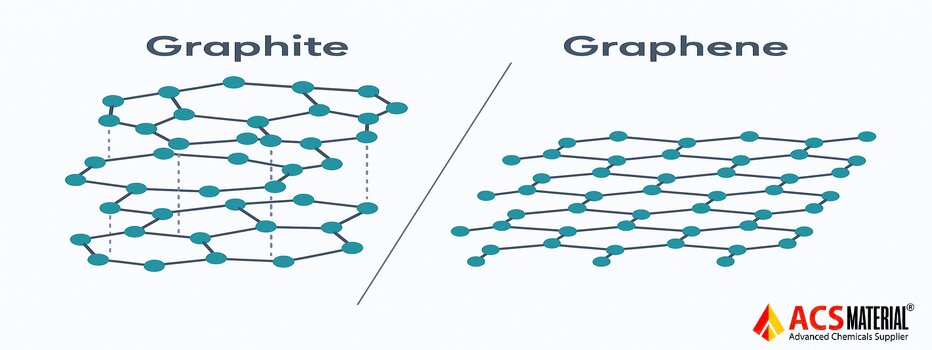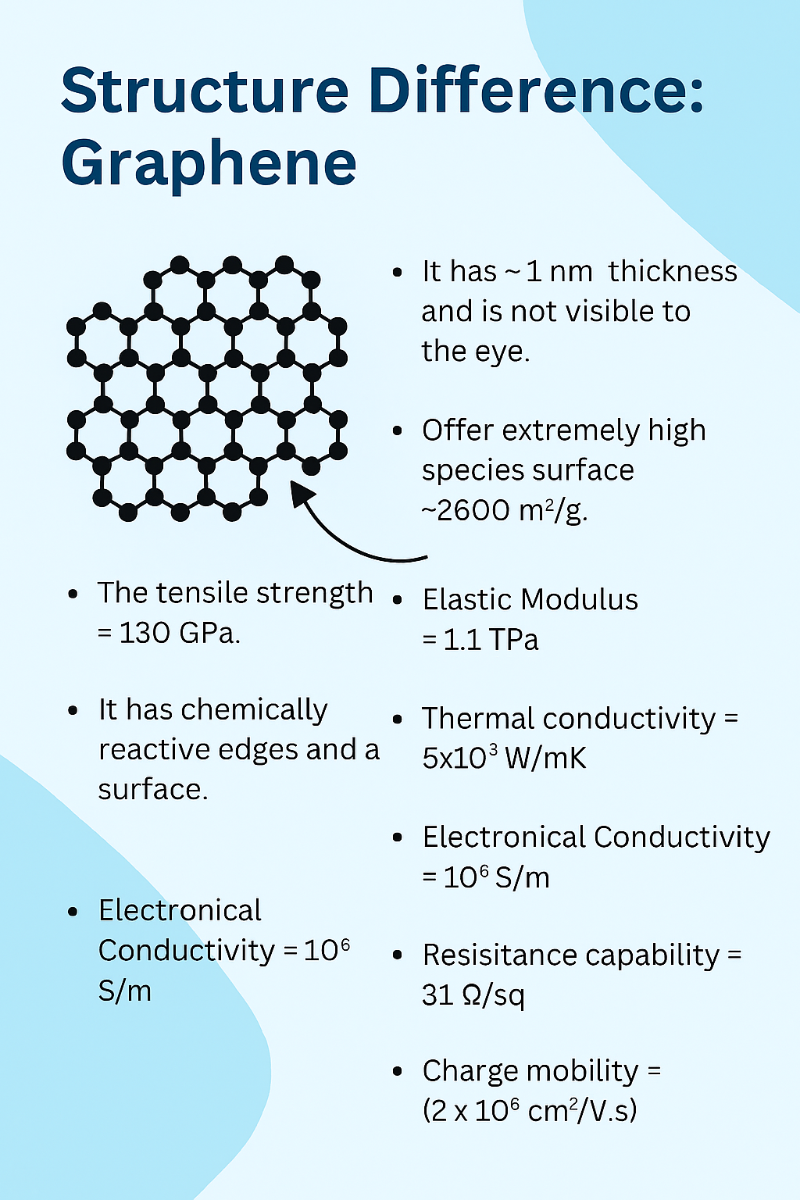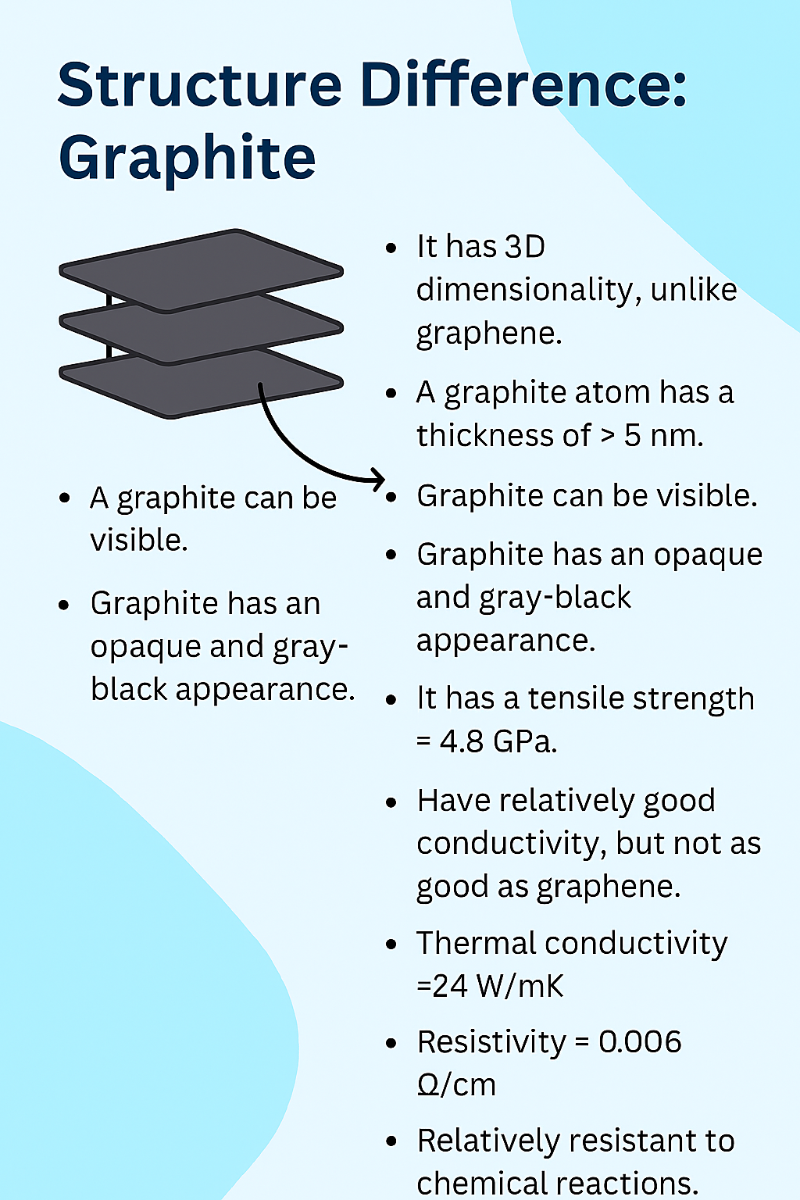-
Graphene vs. Graphite: What’s the Difference?
Oct 01, 2025 | ACS MATERIAL LLCMultiple allotropes from diamond to fullerenes manifest the exquisiteness of carbon, which is a diverse element in nature. Additionally, two forms of carbon, which are famous among the industries, are graphene and graphite. Many people confuse them, but they are entirely different forms.
One has fueled the industries for centuries, while the other is redefining the future of technology at the atomic scale. Graphite has been considered the unrecognized element in industries for years. It features qualities like flexibility, conductivity, and independence. Therefore, experts use it in steelmaking, refractories, and lithium-ion batteries.
Similarly, graphene is famous as a “supermaterial”, in modern manufacturing industries and lab research. It has excellent durability, flexibility, and electrical and thermal conductivity. So, let’s jump into the discussion for clear differentiation of graphene vs. graphite.
Structure Difference: One Layer vs. Many Layers
Strength & Flexibility: Tiny but Mighty
Graphene has incredible strength; a sheet just one atom thick can support heavy loads without breaking. Therefore, scientists consider them tougher materials than metals as well.
The 2-dimensional arrangement makes it the thinnest material and retains its durability and conductivity. Although it’s 200 times stronger, it remains ultralightweight and flexible, which makes it ideal for aerospace materials, composites, and advanced structures.
Graphite is much weaker than graphene; however, its experts have increased its durability at high temperatures. It lacks flexibility because the stacked layers can slide apart easily due to weak van der Waals forces.
Read Also: Graphene and Its Uses in Organic Solar Cells
The softness of graphite makes it worthy to use in pencils and lubricants. For manufacturers seeking flexibility and adaptability, graphite and graphene product suppliers are imperative to make formulations that ensure durability and flexibility.
High Electrical Conductivity
Research proves that graphene is famous for providing exceptional thermal and electrical conductivity in industries. Despite this, the electrons move through with minimal resistance, making them highly desirable for applications in energy storage and the electric sector. Besides, it has the highest electronic mobility ever measured. Thus, experts use CVD graphene (chemical vapor deposition graphene) in sensors, solar cells, and advanced transistors.
Graphite remains a good conductor, but its efficiency is reduced due to electron scattering that occurs between multiple layers. For these reasons, CVD graphene becomes preferable in flexible circuits and sensors. Whether you are dealing with smartphones or supercapacitors, selecting the Best CVD Graphene Supplier to obtain high-quality materials can maximize performance.
Read Also: Graphene and Its Application in Electronics
Surface Area & Chemical Edge
Between the comparison of graphene vs. graphite, surface area is another essential element. Graphene offers a theoretical surface area of ~2,600 m²/g, which ensures its high effective performance in sensing, energy storage, and adsorption.
Graphite oxide is a denser material because of its tightly packed layers, which means it has less area for reactions. Conversely, graphene is thin and open, which gives it a huge surface area even for the smallest amount of chemicals. This quality makes graphene far better than graphite and shines in energy devices, supercapacitors, and batteries.
Unique Chemistry & Reactivity
Graphene with every atom exposed to the environment demonstrates higher surface reactivity.
This unique chemical reactivity of graphene makes it demanding for advanced applications. Its hexagonal and flexible structure allows property tuning for biotechnology.
Variations like Carboxyl Graphene or Graphene on PET substrates are designed by experts to fulfill the specific industrial requirements. And, this becomes possible due to the graphene’s highly reactive surface.
-
Graphene on PET substrates makes transparent conductive films that are high-performing for solar panels or flexible displays.
-
Carboxyl graphene ensures the delivery of functional groups that increase its bonding with polymers and make it useful in coatings and composites.
-
Graphene on Copper Foil is another form that researchers and scientists use to grow high-quality graphene sheets through the chemical vapor deposition method.
Read Also: Graphene: A Complete Chemical History
On the other hand, graphite is a chemically stable material but less versatile. Despite this, graphite restricted the reactivity because most of its atoms are buried within the stacks.
Thus, graphene’s ability to be modified with different chemical groups means that industry often needs to rely on Specialized Graphene Oxide Suppliers to help create custom solutions.
Read Also: Introduction to Graphene Oxide
Synthesis Cost and Scalability
Graphene has incredible potential; however, producing it at a large scale is costly for the industries. In this regard, advancements in methods like exfoliation and CVD are helping to overcome synthesis issues without compromising quality.
Alternatively, graphite is a naturally abundant and inexpensive material. Therefore, experts consider them an outstanding possibility for bulk applications such as steelmaking and battery anodes. Furthermore, industries are channeling investment into refining production methods for Graphene Series products to meet the commercial demand.
Read Also: Graphene: Super Strength for the 21st Century
Doesn’t the End: What Next?
The above discussion explains the difference between graphene vs. graphite. The properties of graphite demonstrate its importance in applications such as lubricants and batteries. Meanwhile, graphene makes its contribution due to its insane properties in nanotechnology, energy storage, and next-generation electronics.
As industries bridge the gap between lab research and large-scale production, the demand for specialized graphene product suppliers is increasing for custom formulations. Advanced graphene oxide suppliers, such as ACS Materials, help manufacturers continue their success.
With the understanding of graphical reliability and graphene transformational properties, carbon truly remains important in traditions and innovations. Follow us on Facebook and X to stay notified of our latest news and updates.
FAQ
Q. Can graphene outmatch the strength of diamond?
A. Graphene can surpass diamond in tensile strength, which makes it an incredibly tough option. In contrast, diamond remains harder and is highly scratch-resistant.
Q. How much graphene provides thermal conductivity?
A. The thermal conductivity of graphene is 5 × 10 103 W/mK, whereas graphite has 24 W/mK.
Q. Can graphite be considered 100% carbon?
A. Yes, graphite is pure carbon atoms that are organized in tightly stacked layers.
Q. Can graphene stop a bullet?
A. When synthesizing the graphene, it becomes stronger and has remarkable energy absorption, which makes it promising for the future of bullet-resistant material.
Q. Which one is more lightweight, graphene or graphite?
A. Graphene is ultra-thin and lighter than graphite because it’s a single-atom-thick sheet. Alternatively, graphite consists of many stacked layers of graphene. -


